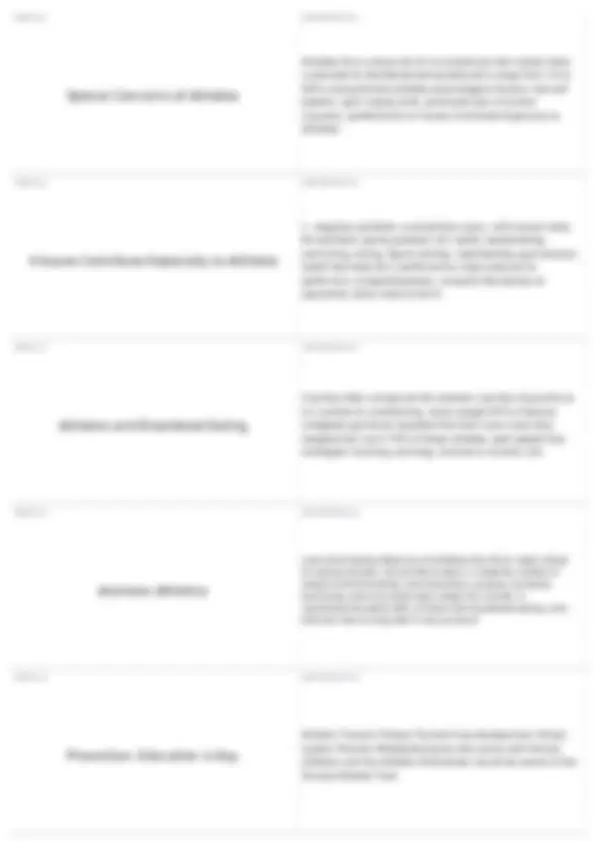





Study with the several resources on Docsity

Earn points by helping other students or get them with a premium plan


Prepare for your exams
Study with the several resources on Docsity

Earn points to download
Earn points by helping other students or get them with a premium plan
Community
Ask the community for help and clear up your study doubts
Discover the best universities in your country according to Docsity users
Free resources
Download our free guides on studying techniques, anxiety management strategies, and thesis advice from Docsity tutors
Comprehensive information about eating disorders, including definitions, prevalence, warning signs, contributing factors, and prevention strategies. Topics covered include anorexia nervosa, bulimia nervosa, disordered eating in athletes, and prevention through education and family support. This resource is essential for anyone seeking to understand the complex nature of eating disorders and how to identify and support those affected.
Typology: Quizzes
1 / 7

This page cannot be seen from the preview
Don't miss anything!




represents a temporary or mild change in eating behaviorrarely persist; does not require professional intervention TERM 2
DEFINITION 2 Eating disorders represent illnesses that seriously interfere with ones daily activitiesanorexia nervosa, bulimia nervosa, & binge-eating disorder TERM 3
DEFINITION 3 core attitudes, coping strategies, & conditions that share emotionally based, inordinate, pathological focus on body shape/weight TERM 4
DEFINITION 4 true TERM 5
DEFINITION 5 Eating disorders:
(some males (10%) & adults) 1-5% of general population 2- 6% of high school & college aged ballet dancers 1 in 5 (20%) TERM 7
DEFINITION 7 believe they are fat; though maythinNOT just a problem with food or weight tool to deal with emotional problems TERM 8
DEFINITION 8 starve themselves, avoid high calorie foods & may over exercise 1-2% general population hungry very often & like this feeling (control) good at something TERM 9
DEFINITION 9 eat a lot (binge); vomit (purge) or may take laxatives2-6% general population dont usually lose as much weight as those with anorexia May have both conditions simultaneously TERM 10
DEFINITION 10 Usually good students & involved Desire for perfection Blame self if not perfectUsually begins with normal attempt for weight loss turns into obsession events in life pre-dispose them May believe they would be happier or successful if thin
1/32/3 have histories of sexual or physical abusemay unconsciously avoid further sexual attention by losing enough weight TERM 17
DEFINITION 17 1/3-1/2 of report having struggled with depression or anxiety before their eating disorder began TERM 18
DEFINITION 18
DEFINITION 19 ox hunger insatiable appetite More common than anorexia nervosa 2-6% of general pop. Frequent binges of eating followed by guilt & purging (1000-10,000 cals) eat calorie dense foods in women related to emotional state (reduce stress) Experience loss of control (purging regains control) Recognize behavior as abnormal Not always thin (large range in body size) Abuse alcohol & drugs more TERM 20
DEFINITION 20 Excessive concern about body weight Frequent gains & loses of weight Visits to bathroom following meals Fear of not controlling eating Eating when depressed Severe mood shifts Frequent criticism of weight Personal or family problems Irregular menstrual cycle (dysmenorrhea) **Discoloration of teeth
Athletes face unique set of circumstances that makes them vulnerable to disordered eating behaviors range from 15 to 62% among female athletes psychological factors: low self esteem, poor coping skills, perceived loss of control (injuries), perfectionism 4 Issues Contribute Especially to Athletes TERM 22
DEFINITION 22
DEFINITION 23 Coaches often compound the problem coaches should focus on nutrition & conditioning, never weight 67% of female collegiate gymnasts reported that their coach said they weighed too much 75% of these athletes used weight loss strategies involving vomiting, laxative or diuretic use TERM 24
DEFINITION 24 sub-clinical eating behaviors of athletes who fail to meet criteria for eating disorder, but exhibit at least 1 unhealthy method of weight controlIncluding: semi-starvation, purging, excessive exercising used to achieve body weight for success in sportsExercise addict 50% of those with disordered eating, over- exercise How do they feel if miss workout? TERM 25
DEFINITION 25 Athletic Trainers Fitness Trainers Coaches/teachers School system Parents AthletesEveryone who works with female athletes and the athletes themselves should be aware of the Female Athlete Triad
Optimal performance requires equal effort with nutrition and training this generations eating habits are far from where they need to be There is no quick fix, but it also does not require a lot of effort create simple strategies to modify the diet instead of unrealistic changes We need to eat meals not graze Pre/during/post nutrition is a hot topic and everyone wants to know about it TERM 32
DEFINITION 32 You better learn about supplements they are not going away If you cant answer your athletes/clients questions Intense exercise requires more than water Create handouts foods they like/dont like barriers create strategies antioxidant foods TERM 33
DEFINITION 33 Covered Chapters: (40-50 questions) Supplements (Chapters 11 &